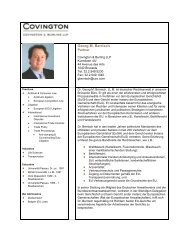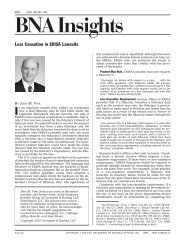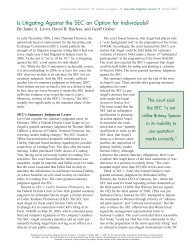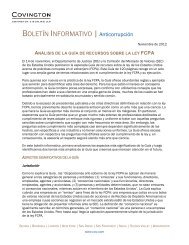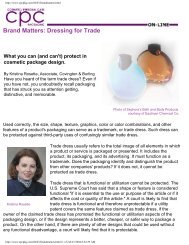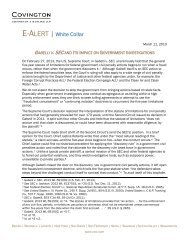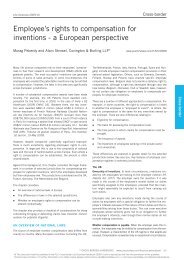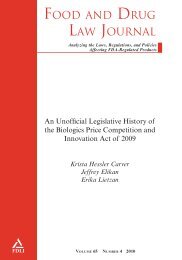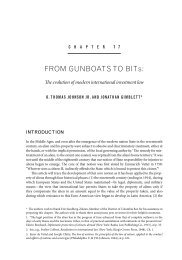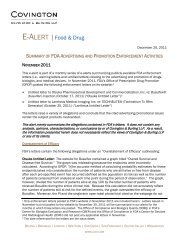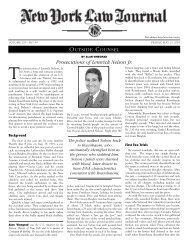Conflict Mineral Rules: Frequently Asked Questions - Covington ...
Conflict Mineral Rules: Frequently Asked Questions - Covington ...
Conflict Mineral Rules: Frequently Asked Questions - Covington ...
You also want an ePaper? Increase the reach of your titles
YUMPU automatically turns print PDFs into web optimized ePapers that Google loves.
ADVISORY | Securities<br />
CONFLICT MINERAL RULES: FREQUENTLY ASKED QUESTIONS<br />
BEIJING | BRUSSELS | LONDON | NEW YORK | SAN DIEGO | SAN FRANCISCO | SEOUL | SILICON VALLEY | WASHINGTON<br />
www.cov.com<br />
January 3, 2013<br />
The Securities and Exchange Commission’s (SEC) conflict mineral rules, adopted in August 2012,<br />
present hard questions for public companies, which must evaluate whether they are covered by the<br />
rules, and, if so, make inquiry into the origin of the minerals used in their products. The rules are<br />
complex and leave much to interpretation based on particular facts and circumstances. Further, the<br />
rules endorse an international due diligence framework that is somewhat untested and will continue<br />
to evolve as the impact of the rules takes effect.<br />
This advisory reviews a range of questions that companies are addressing under the rules. Although<br />
we expect the staff of the SEC to give guidance on some of these, it is not clear when, or to what<br />
extent, that will happen, and we caution that many of the questions covered in this advisory must be<br />
interpreted by companies based on their own situations.<br />
BRIEF BACKGROUND ON THE CONFLICT MINERAL RULES<br />
The SEC adopted the conflict mineral rules under Section 1502 of the Dodd-Frank Wall Street<br />
Reform and Consumer Protection Act (“Dodd-Frank Act”) on August 22, 2012. 1 The rules require<br />
public companies annually to disclose information about their use of specific minerals originating<br />
and financing armed groups in the Democratic Republic of the Congo (“DRC”) or an adjoining<br />
country. The “conflict minerals” are tantalum, tin, tungsten, and gold. 2 The rules will encompass<br />
many public companies because conflict minerals are used to manufacture a wide array of products,<br />
such as smartphones, cameras, computers, microchips, automobiles, tools and heavy machinery.<br />
The rules envision a three-step compliance process, as follows:<br />
FIRST, a company must determine whether it is covered by the rules based on its use of conflict<br />
minerals.<br />
SECOND, a company that is covered by the rules must conduct, in good faith, a “reasonable country<br />
of origin inquiry” that is reasonably designed to determine if the conflict minerals originated in the<br />
covered countries or are from recycled or scrap sources.<br />
1 See <strong>Conflict</strong> <strong>Mineral</strong>s, Rel. No. 34-67716 (Aug. 22, 2012) (“Adopting Release”). The text of the final rules is<br />
included in the Adopting Release which is available on the SEC’s website.<br />
2 More precisely, “conflict mineral” means columbite-tantalite (coltan), cassiterite, gold, wolframite, or their<br />
derivatives. Section 13(p)(5) of the Securities Exchange Act of 1934 (“Exchange Act”) and Section 1502(e)(4)<br />
of the Dodd-Frank Act. The SEC’s rules modify this definition slightly by stating that the derivatives of these<br />
minerals are limited to tantalum, tin and tungsten. Item 1.01(d)(3) of Form SD. The Secretary of State can<br />
designate additional conflict minerals by making a determination that the minerals or their derivatives are<br />
financing conflict in the DRC or an adjoining country. To date, the Secretary of State has not made such a<br />
determination.
COVINGTON & BURLING LLP<br />
THIRD, a company that determines that its conflict minerals originated in the covered countries and<br />
are not from recycled or scrap sources, or has reason to believe that its conflict minerals may have<br />
originated in the covered countries and may not be from recycled or scrap sources, must exercise<br />
due diligence on the source and chain of custody of its conflict minerals and may need to file a<br />
<strong>Conflict</strong> <strong>Mineral</strong>s Report.<br />
Annex A contains a helpful flow chart from the Adopting Release illustrating this three-step<br />
compliance process.<br />
All disclosures required under the rules will be filed using a newly-created form, Form SD. The first<br />
reports containing required conflicts mineral disclosure will cover the calendar year beginning<br />
January 1, 2013, which means that any public companies that have not yet begun to assess their<br />
status under the rules should act quickly. 3 Although the rules have been challenged in court, the<br />
outcome of the legal challenge is unclear, and, for now, we recommend that public companies<br />
proceed to comply with the rules in the form adopted. 4<br />
For a detailed description of the new rules, please see our firm’s client advisory on the new rules.<br />
STEP ONE - DETERMINING WHETHER A COMPANY IS COVERED BY THE RULES<br />
A company will be covered by the rules if it meets the following two criteria:<br />
it files reports with the SEC under Section 13(a) or 15(d) of the Exchange Act (this includes<br />
domestic companies, foreign private issuers, and smaller reporting companies), and<br />
conflict minerals are necessary to the functionality or production of a product manufactured by<br />
the company or contracted by the company to be manufactured.<br />
Although the first of these criteria is generally straightforward, the use of the term “registrant” in the<br />
rules creates at least some question as to whether a company’s subsidiaries and other related<br />
entities are covered by the rules. While there is no clear answer in the rules, we believe the term<br />
“registrant” in this context could well be interpreted to cover a company’s subsidiaries, and, likely, its<br />
controlled (or at least consolidated) entities. Nonetheless, it will be important to review any<br />
applicable guidance offered by the SEC staff on this issue.<br />
The second of these criteria use terms that are not defined in the rules, such as “product,”<br />
“manufacture,” “contract to manufacture,” and “necessary to the functionality or production.” The<br />
meaning of these terms must be interpreted and applied by companies based on their specific facts<br />
and circumstances, and in light of the somewhat limited guidance offered by the SEC in the Adopting<br />
Release. Below are a number of questions that public companies may wish to consider when<br />
determining whether they are covered by the rules.<br />
3 The first Form SD’s, in respect of the year ending December 31, 2013, will be due by May 31, 2014.<br />
4 A petition for review of the rules was filed with the Court of Appeals for the D.C. Circuit on October 19, 2012<br />
by the National Association of Manufacturers and the U.S. Chamber of Commerce (the Business Roundtable<br />
subsequently joined as an additional petitioner). Among the issues raised by petitioners is whether the SEC’s<br />
economic analysis of the new rules is inadequate, whether the SEC should have included a de minimis<br />
exception under the rules, and whether certain provisions in the rules, such as covering companies that<br />
“contract to manufacture” products containing conflict minerals, are erroneous, arbitrary and capricious, or an<br />
abuse of discretion.<br />
C&B<br />
2
COVINGTON & BURLING LLP<br />
Is there any guidance on the meaning of “product”?<br />
There is very little guidance from the SEC on the meaning of “product” in the context of the rules.<br />
The term is significant because the rules apply to “products” containing conflict minerals. Thus, it is<br />
important for companies, as a threshold matter, to define what constitutes a product for purposes of<br />
the rules. In this regard, some companies have pointed to the distinction between “products” and<br />
“services” as one way to bound the inquiry (although mixed offerings that incorporate both products<br />
and services muddy this distinction). Others have raised questions about whether a “product”<br />
should be viewed as including the packaging or its other means of delivery.<br />
While the Adopting Release does not directly address the question of what constitutes a product, it<br />
does suggest that, in order to be covered by the rules as a product, an item must be entered into the<br />
stream of commerce by being offered to third parties for consideration.<br />
For products or services that are delivered to consumers using a device or mechanism containing<br />
conflict minerals, how is the “product” defined?<br />
There are myriad products and services that are delivered to consumers using a device or<br />
mechanism that might not be considered a core part of the product or service in the eyes of the<br />
consumer. Examples include, among other things, cable television programming delivered by means<br />
of a set-top box, music or software delivered by means of compact disc, and movies or other video<br />
programs delivered by means of a DVD.<br />
If a delivery mechanism is separately sold or rented to the consumer apart from the related product<br />
or service, as is often the case with a cable set-top box, for example, the delivery mechanism is<br />
arguably entered into the stream of commerce and, consistent with the guidance in the Adopting<br />
Release, would potentially be considered a “product” covered by the rules.<br />
Where there is no separate consideration paid for the delivery mechanism, it is still necessary to ask<br />
whether the delivery mechanism is so bound up in the functionality of the product as to be<br />
appropriately considered part of the product itself. Numerous scenarios implicate this issue. For<br />
example, software is a product which, on its own, does not contain conflict minerals, but which may<br />
be delivered to the consumer using a device or mechanism (such as a compact disc) which might<br />
contain conflict minerals. Another example is music, movies or other entertainment, which<br />
consumers may obtain over the internet, but which also can be delivered by means of a device or<br />
mechanism such as a DVD that might contain conflict minerals.<br />
As a separate inquiry, even where the delivery mechanism is determined to be part of the product, a<br />
company might consider whether any conflict mineral included in the delivery mechanism is<br />
“necessary to the functionality” of the product in question.<br />
What steps should a company take to determine whether its products contain conflict minerals?<br />
The rules do not lay out specific steps that must be followed. We expect that many companies are<br />
assembling internal, multi-disciplinary teams and are reviewing documents such as bills of materials,<br />
purchase contracts, material safety data sheets (MSDS), product specifications, and statements of<br />
work, among other things, to get at the issue of what minerals are included in a product. In all<br />
likelihood, many companies will also engage with suppliers, even beyond the first tier, to ascertain<br />
the mineral content of their products. The OECD Due Diligence Guidance 5 provides useful guidance<br />
5 The Due Diligence Guidance for Responsible Supply Chains of <strong>Mineral</strong>s from <strong>Conflict</strong>-Affected and High-Risk<br />
Areas (2011) (the “OECD Due Diligence Guidance”), was published by the Organisation for Economic<br />
Cooperation and Development (the “OECD”). This guidance incorporates a Tin, Tantalum and Tungsten<br />
C&B<br />
3
COVINGTON & BURLING LLP<br />
on steps a company can take to engage with its suppliers to obtain information about the mineral<br />
content of its products.<br />
Is there a de minimis exception under the rule?<br />
No. The SEC stated in the Adopting Release that it would be contrary to the statutory provision to<br />
include an exception for products containing only de minimis amounts of a conflict mineral. As a<br />
result, even trace amounts of conflict minerals can be considered necessary to the functionality or<br />
production of the product.<br />
On the other hand, the Adopting Release makes clear that some amount of conflict mineral must<br />
actually be contained in the product in order to be within the scope of the rules. This is an important<br />
threshold concept and also represents an important change from the proposed rules, which, the SEC<br />
had suggested, would cover not only conflict minerals contained in a product, but also conflict<br />
minerals that were intentionally included in the production process of the product, even if they were<br />
not contained in the finished product.<br />
Is there any guidance on the meaning of “manufacture”? Does it include the assembly of products?<br />
There is no definition of the term “manufacture” in either the rules or the Adopting Release because<br />
the SEC believes the term is generally understood. However, the Adopting Release states that the<br />
SEC does not consider a company to “manufacture” a product if it only services, maintains or repairs<br />
the product.<br />
The Adopting Release also states that the North American Industry Classification System’s (NAICS)<br />
definition of “manufacturer” is too narrow in that it appears to exclude an issuer that manufactures a<br />
product by assembling the product from materials, substances or components that are not in raw<br />
material form. As a result, the Adopting Release goes on to say, this definition would exclude large<br />
categories of issuers that manufacture products through assembly, such as auto and electronics<br />
manufacturers. Thus, absent further staff guidance, we think it is likely that a company that<br />
assembles its products using component parts would be viewed as the “manufacturer” of that<br />
product.<br />
By contrast, if a company contracts with a manufacturer to assemble that manufacturer’s products<br />
for a fee, we think such company would most appropriately be viewed as providing a service, and not<br />
selling a product. This assumes that the assembler in this scenario does not itself sell the products<br />
into the stream of commerce for its own account.<br />
What factors should be considered in determining whether a company “contracts to manufacture” a<br />
product or component?<br />
Whether a product is “contracted to be manufactured” by a company depends on the degree of<br />
influence the company exercises over the manufacturing of the product, including its influence over<br />
the materials, parts, ingredients or components to be included in the product.<br />
There is no bright line test. Whether and the degree to which a company exercises influence over<br />
the manufacturing of a product through a contract will require a highly fact-intensive analysis. The<br />
Supplement. The OECD also adopted a Gold Supplement in July 2012 but has not yet incorporated that<br />
supplement into the OECD Due Diligence Guidance. The Gold Supplement is available online.<br />
C&B<br />
4
COVINGTON & BURLING LLP<br />
Adopting Release makes clear, however, that a company must have some actual influence over the<br />
manufacturing of the product in order to be covered by the rules.<br />
While the question of influence over the manufacturing of a product will depend on the facts and<br />
circumstances, the Adopting Release states that a company should not be viewed as contracting to<br />
manufacture a product if it does no more than:<br />
specify or negotiate contractual terms that do not directly relate to the manufacturing of the<br />
product, such as training or technical support, price, insurance, indemnity, intellectual property<br />
rights, dispute resolution or similar terms, unless the company does so in such a way that it<br />
influences the manufacturing of the product in a manner practically equivalent to contracting on<br />
terms that directly relate to the manufacturing of the product;<br />
affix its brand, marks, logo or label to a generic product manufactured by a third party; or<br />
service, maintain or repair a product manufactured by a third party.<br />
The SEC provides an illustration of how these principles should be applied -- the Adopting Release<br />
states that a service provider that specifies to a manufacturer that a cell phone it will purchase from<br />
the manufacturer to sell at retail must be able to function on a certain network does not in-and-ofitself<br />
exert sufficient influence to be viewed as contracting to manufacture the phone for purposes of<br />
the rules.<br />
However, in a situation where a company’s specification of performance standards would inevitably<br />
or naturally require the use of conflict minerals, even if the company does not specify that such<br />
conflict minerals be used, the company may be exerting a sufficient degree of influence over the<br />
content of the product such that it would be deemed to be “contracting to manufacture” the product.<br />
Retailers generally should not be covered by the rules. However, retailers that exert sufficient<br />
influence over the manufacturing of products they sell by, for example, specifying the materials,<br />
parts, ingredients or components to be included in the product, may be covered by the rules if<br />
conflict minerals are necessary to the functionality or production of those products.<br />
Is there leeway to determine that a conflict mineral that is intentionally added to a product is not<br />
“necessary to the functionality” of the product?<br />
The Adopting Release lays out the following three, non-exclusive factors that companies should<br />
consider in determining whether a conflict mineral is necessary to the functionality of a product:<br />
whether a conflict mineral is contained in and intentionally added to the product or any<br />
component of the product and is not a naturally-occurring by-product;<br />
whether a conflict mineral is necessary to the product’s generally expected function, use, or<br />
purpose; and<br />
if a conflict mineral is incorporated for purposes of ornamentation, decoration or embellishment,<br />
whether the primary purpose of the product is ornamentation or decoration.<br />
The Adopting Release states that any of these factors, either individually or in the aggregate, may be<br />
determinative as to whether conflict minerals are “necessary to the functionality” of a given product.<br />
These three factors are inter-related to some degree, as it will often be the case that a conscious<br />
decision to incorporate a specific mineral denotes the importance of that mineral to the product’s<br />
generally expected function or use. The Adopting Release does seem to suggest that there is a<br />
presumption that a conflict mineral intentionally added to a product should be considered necessary<br />
to the functionality of that product, as the decision to add the mineral naturally begs the question of<br />
C&B<br />
5
COVINGTON & BURLING LLP<br />
why it was added. Still, the release’s amorphous language should give companies some leeway to<br />
determine, in appropriate scenarios, that a conflict mineral that is intentionally added to a product<br />
might not be “necessary” to that product’s generally expected function, use or purpose.<br />
Regarding the third factor, the Adopting Release states that, where a conflict mineral is incorporated<br />
into a product for purposes of ornamentation, decoration, or embellishment, and the primary<br />
purpose of the product is not ornamentation or decoration, it is less likely to be “necessary to the<br />
functionality” of the product.<br />
When is a conflict mineral “necessary to the production” of a product?<br />
The rules do not define when a conflict mineral is necessary to the production of a product, but the<br />
Adopting Release states that a company should consider whether the conflict mineral is intentionally<br />
added in the product’s production process, including the production process of any of the product’s<br />
components, and whether the conflict mineral is necessary to produce the product. As noted above,<br />
however, the Adopting Release makes clear that some amount of conflict mineral must actually be<br />
contained in a product for the mineral to be considered necessary to the production of the product.<br />
Thus, a conflict mineral used in the production of a product, but not present in the product itself—<br />
such as a catalyst, no part of which remains in the final product—would not be considered necessary<br />
to the production of the product. The Adopting Release also clarifies that a physical tool or machine<br />
— such as a wrench, and indirect equipment — such as computers and power lines, used to produce<br />
a product are not covered by the rules, even if they contain conflict minerals and are necessary to<br />
the production of the product.<br />
Must a company consider a product’s packaging in determining whether the company is covered by<br />
the rules with respect to that product?<br />
Yes, generally a company should take into account a product’s packaging when determining whether<br />
the company might be covered by the rules. In thinking about a product’s packaging, the company<br />
may wish to consider several threshold questions:<br />
Is it appropriate to consider the packaging as part and parcel of the “product,” or is the<br />
packaging separate and distinct from the product? For example, a cardboard shipping box used<br />
to ship a product probably should not be considered part of the “product,” but a tin can used to<br />
package food goods might be considered part of the “product.”<br />
If the packaging contains conflict minerals, are those minerals “necessary to the functionality” of<br />
the product in question? For example, a can used for canned food might be viewed as necessary<br />
to the functionality of the canned food if the can has been chosen as the container for the food<br />
due to the attributes that it contributes to the combined product, including, for example,<br />
freshness, flavor, or its ability to preserve the food it contains.<br />
Is the conflict mineral used for ornamentation or decoration? If so, the Adopting Release<br />
suggests that the mineral would likely not be considered “necessary to the functionality” of the<br />
product, unless the primary purpose of the product in question is ornamentation or decoration.<br />
How are R&D materials treated under the rules?<br />
The Adopting Release provides that materials, prototypes, and other demonstration devices are not<br />
considered to be “products” covered by the rules, even if they contain conflict minerals. However,<br />
once an item is entered in the stream of commerce by being offered to third parties for<br />
consideration, it is deemed a “product” and potentially covered by the rules. This means that a<br />
C&B<br />
6
COVINGTON & BURLING LLP<br />
supplier of R&D prototypes or components containing conflict minerals that are necessary to the<br />
functionality of such items would be covered by the rules, if it sells such items to other companies.<br />
STEP TWO -- REASONABLE COUNTRY OF ORIGIN INQUIRY<br />
If a company determines that it is covered by the rules, it must conduct, in good faith, a “reasonable<br />
country of origin inquiry” that is reasonably designed to determine if such conflict minerals originated<br />
in the covered countries or come from recycled or scrap sources.<br />
Below are a number of questions that public companies may wish to consider when designing their<br />
reasonable country of origin inquiry.<br />
Has the SEC provided any guidance on how companies should approach the reasonable country of<br />
origin inquiry?<br />
Neither the rules nor the Adopting Release specifies the steps necessary to meet the reasonable<br />
country of origin inquiry requirement. This is because the SEC has said that it believes that the<br />
scope of the inquiry will depend on each company’s particular facts and circumstances and may vary<br />
based on a company’s size, products, relationships with suppliers, or other factors.<br />
However, the SEC stated in the Adopting Release that it views an acceptable reasonable country of<br />
origin inquiry as one that follows the “supplier engagement” approach in the OECD Due Diligence<br />
Guidance. As its name suggests, this approach contemplates that companies will engage with the<br />
companies in their supply chain to make inquiries about the source of the conflict minerals and the<br />
smelters or refineries used to process the minerals. Broadly speaking, the OECD supplier<br />
engagement model encompasses a range of activities, such as communicating the company’s<br />
sourcing policy and commitments to its suppliers, educating suppliers about the conflict minerals<br />
reporting obligation, and requesting and collecting information from suppliers regarding, for example,<br />
mineral content, the source of conflict minerals, the smelters or refineries used to process the<br />
minerals, and whether the conflict minerals come from recycled or scrap sources.<br />
The OECD’s Due Diligence Guidance also recognizes that companies may find it difficult to engage<br />
with upstream suppliers beyond their direct suppliers, and, in these circumstances, the OECD<br />
guidance encourages companies to cooperate with members in their industry with whom they share<br />
suppliers to identify the smelters or refineries in the supply chain. The guidance also suggests that a<br />
company can “push down” the reporting obligation so that its direct suppliers engage with their<br />
direct suppliers to gather the necessary information, and so on up the supply chain.<br />
The OECD Due Diligence Guidance contemplates evolution and development of the due diligence<br />
process to take into account changes in circumstances, the development of traceability protocols,<br />
and emerging consensus regarding best practices. Companies are advised to monitor developments<br />
regarding the OECD’s Due Diligence Guidance so that they can adapt their reasonable country of<br />
origin inquiries, as appropriate under the circumstances, to evolving standards.<br />
What types of supplier representations can a company rely upon in conducting its reasonable<br />
country of origin inquiry?<br />
As noted above, the rules and the Adopting Release do not specify the steps necessary to meet the<br />
reasonable country of origin inquiry requirement. The Adopting Release does, however, contain<br />
some guidance regarding the use of representations from suppliers that should be taken into<br />
account when structuring the reasonable country of origin inquiry. One noteworthy passage is as<br />
follows:<br />
C&B<br />
7
COVINGTON & BURLING LLP<br />
“we … view an issuer as satisfying the reasonable country of origin inquiry standard if it seeks and<br />
obtains reasonably reliable representations indicating the facility at which its conflict minerals were<br />
processed and demonstrating that those conflict minerals did not originate in the Covered Countries<br />
or came from recycled or scrap sources. These representations could come either directly from that<br />
facility or indirectly through the issuer’s immediate suppliers, but the issuer must have a reason to<br />
believe these representations are true given the facts and circumstances surrounding those<br />
representations.” (emphasis added)<br />
This suggests that the SEC expects that, in order to be relied upon, a supplier’s representations must<br />
be based on something demonstrable regarding the source of origin of the minerals - e.g., being<br />
sourced from a certified “conflict free smelter.” This passage also suggests, by contrast, that it might<br />
not be sufficient to rely solely on flat representations from suppliers that they do not use conflict<br />
minerals sourced from the DRC region.<br />
In this regard, it is instructive that the OECD Due Diligence Guidance contemplates that, as part of<br />
the supplier engagement process, a company would inquire of its Tier 1 (direct) suppliers regarding<br />
the mineral content of the supplier’s products or components, the names of smelters/refineries used<br />
in the supplier’s chain of supply, and whether any minerals are from recycled or scrap sources. The<br />
OECD guidance suggests that each supplier will, in turn, elicit the same information from the lowerlevel<br />
suppliers up the chain.<br />
Note also that the Electronic Industry Citizenship Coalition (“EICC”) and the Global e-Sustainability<br />
Initiative (“GeSI”) have developed a <strong>Conflict</strong>-Free Smelter Program through which they coordinate<br />
and oversee independent audits of smelters that process conflict minerals. EICC and GeSI are<br />
compiling lists of compliant tantalum, tin and tungsten smelters and gold refiners. 6 They also have<br />
developed a spreadsheet template for companies to use when gathering information from their<br />
supply chains. 7 These tools contemplate that companies will ascertain the identities of the smelters<br />
used to process the conflict minerals contained in the companies’ products.<br />
Because each company’s inquiry must necessarily be tailored to its particular circumstances, in<br />
some situations a company might be able to meet the reasonable country of origin inquiry standard<br />
by getting representations only from its direct suppliers. While we tend to think this type of inquiry<br />
will normally not be sufficient, factors that could influence the determination about the adequacy of<br />
such an inquiry might include, among other things, the company’s familiarity with, and the<br />
transparency of, the supply chain, the length of the supply chain, whether the direct suppliers have a<br />
substantial market presence and serve a large number of customers who will also be relying on the<br />
supplier’s representations for conflict minerals reporting, and the absence of warning signs that<br />
might raise questions about the reliability of the supplier’s representations.<br />
Will a company’s reasonable country of origin inquiry be sufficient if it does not receive responses<br />
from all of its suppliers?<br />
The Adopting Release states clearly that a sufficient reasonable country of origin inquiry does not<br />
require a company to receive input from its entire supply chain, as long as the company’s inquiry is<br />
reasonably designed and conducted in good faith, and the company does not ignore warning signs<br />
indicating that some of its conflict minerals may have originated in the covered countries.<br />
6 The lists of compliant smelters and refiners are available online at<br />
http://www.conflictfreesmelter.org/cfshome.htm.<br />
7 The <strong>Conflict</strong> <strong>Mineral</strong>s Reporting Template is available online at<br />
http://www.conflictfreesmelter.org/<strong>Conflict</strong><strong>Mineral</strong>sReportingTemplateDashboard.htm.<br />
C&B<br />
8
COVINGTON & BURLING LLP<br />
We don’t think there should be any hard and fast standards about an acceptable level of response,<br />
with each company basing its determination on its unique facts and circumstances. Logically,<br />
however, there is likely to be a direct correlation between the response rate and the reasonableness<br />
of a company’s inquiry into the origin of the conflict minerals in its products.<br />
We also tend to think that a risk-based approach would be appropriate, under which a greater level<br />
of scrutiny would be applied to the smaller sub-set of suppliers with the largest concentration of<br />
products containing conflict minerals, with a lesser degree of scrutiny applied to other suppliers.<br />
Other criteria that might form a basis for such a risk-based approach include the volume of conflict<br />
minerals consumed by a supplier, and the relative strategic or financial importance of a supplier.<br />
Further, where one supplier accounts for a disproportionate volume of a particular conflict mineral, it<br />
would be prudent to ensure that a response is received from that supplier, even where the company<br />
has received responses from nearly all other suppliers.<br />
To the extent that a company does not receive responses from all of its suppliers, it should not<br />
ignore warning signs indicating that some of its conflict minerals may have originated in the covered<br />
countries. The Adopting Release notes two examples of circumstances that, absent other<br />
information, should give a company reason to believe that its conflict minerals may have originated<br />
in the covered countries: (i) a company becomes aware that some of its conflict minerals were<br />
processed by smelters that sourced from many countries, including the covered countries, and the<br />
company is unable to determine whether the conflict minerals it received from such a “mixed<br />
smelter” were from the covered countries; and (ii) conflict minerals are claimed to originate from a<br />
country that has limited known reserves of the conflict mineral in question.<br />
May a company’s reasonable country of origin inquiry be informed by third parties, such as<br />
consultants?<br />
Nothing in the rules or the Adopting Release rules out input from third parties, such as consultants,<br />
in the reasonable country of origin inquiry. But, because the SEC thinks an acceptable country of<br />
origin inquiry should be based on “supplier engagement,” such input will be most useful when it<br />
supplements, rather than supplants, meaningful information gathered directly from suppliers.<br />
If a consultant or other third party is used in this process, we think it is advisable for the company to<br />
work with the consultant to ensure that the company has a reasonable basis for relying on the<br />
consultant’s conclusions and work product. For example, companies that use consultants may wish<br />
to request copies of documentary evidence supporting the consultant’s work, so that the company<br />
can review the consultant’s work itself and form a basis for relying on the conclusions. By contrast, a<br />
“black box” approach (where the company has no visibility into the consultant’s work or underlying<br />
evidence) is likely not acceptable. In other words, we think the company should be able to exercise<br />
some independent judgment and have its own basis for drawing conclusions about the country of<br />
origin of the conflict minerals.<br />
How are recycled or scrap metals treated under the rules?<br />
If a company’s reasonable country of origin inquiry permits the company to know, or reasonably<br />
believe, that the conflict minerals in its products came from recycled or scrap sources, the company<br />
need not exercise due diligence, or file a <strong>Conflict</strong> <strong>Mineral</strong>s Report, with respect to such products.<br />
The rules also expressly permit companies to describe their products containing conflict minerals<br />
from recycled or scrap sources as “DRC conflict free.”<br />
For purposes of the rules, conflict minerals are considered to be from recycled or scrap sources if<br />
they are from recycled metals, which are reclaimed end-user or post-consumer products, or scrap<br />
C&B<br />
9
COVINGTON & BURLING LLP<br />
processed metals created during product manufacturing. Recycled metal includes excess, obsolete,<br />
defective and scrap metal materials that contain refined or processed metals that are appropriate to<br />
recycle in the production of tin, tantalum, tungsten and/or gold. <strong>Mineral</strong>s partially processed,<br />
unprocessed or a “bi-product” from another ore are not included in the definition of recycled metal.<br />
While the OECD’s supplier engagement approach contemplates that companies will inquire of their<br />
suppliers regarding whether conflict minerals used in their products came from recycled or scrap<br />
sources, it is not clear whether, and to what extent, industry protocols such as the EICC/GeSI <strong>Conflict</strong><br />
Free Smelter Program will provide companies and their suppliers with a reliable mechanism for<br />
verifying whether the conflict minerals in their products are from recycled or scrap sources.<br />
What are some of the methods, tools and processes being used by companies to conduct their<br />
reasonable country of origin inquiry?<br />
Listed below are some of the current methods, tools and processes we have heard companies may<br />
be using to conduct their reasonable country of origin inquiry. These will change over time as due<br />
diligence guidance, frameworks and resources evolve.<br />
Industry-wide protocols for gathering information from suppliers, such as the EICC and GeSI<br />
reporting template and certification tool. The EICC/GeSI reporting template is an Excel<br />
spreadsheet with a series of questions and data to be filled in. Reporting companies and/or<br />
suppliers in their chain send the reporting template to their lower-tier suppliers; the tool<br />
facilitates compilation of data. 8<br />
Incorporating appropriate language in supplier contracts, and requiring suppliers to adopt or<br />
comply with customer’s supply chain and sourcing policies.<br />
Requiring access to supplier documentation and records regarding their supply chains and<br />
sourcing, and requiring spot checks of suppliers.<br />
EICC/GeSI conflict-free smelter program. Under this program, most companies will be focusing<br />
on the supply chain from the company back to the smelter or refinery where the minerals were<br />
processed. This focus relies on the evolving EICC/GeSI conflict-free smelter program, which is an<br />
effort led by the electronics industry to verify the source of minerals processed at various<br />
smelters and refineries (using audits and other verification tools). Using this program, top-tier<br />
suppliers or companies at the end of the supply chain would be able to know, reliably, whether<br />
the smelters in their supply chain are “conflict-free.” The OECD Due Diligence Guidance<br />
contemplates that, if these protocols work as intended, most companies would not need to<br />
engage with suppliers in the portion of the supply chain from the smelter or refiner back to the<br />
original mine of origin. To date, most progress has been made on the list of compliant tantalum<br />
smelters, while lists for tin and tungsten smelters are in process. 9<br />
Collaborating/sharing data regarding supply chains with industry peers, and collaborating with<br />
peer and industry trade groups on best practices and diligence tools.<br />
Third party consultants. We understand that companies are considering using consultants to<br />
perform a variety of roles with regard to the reasonable country of origin and/or due diligence.<br />
These roles appear to range from advising on the design of an appropriate inquiry, assisting with<br />
the outreach to suppliers and collection of data, aggregating data from suppliers and making it<br />
available to multiple companies, and providing on-the-ground resources to assist with the actual<br />
8 The <strong>Conflict</strong> <strong>Mineral</strong>s Reporting Template is available online.<br />
9 The lists of compliant smelters and refiners are available online.<br />
C&B<br />
10
COVINGTON & BURLING LLP<br />
due diligence. Companies using consultants to assist in, or even handle portions of, the inquiry<br />
should be comfortable that the work of the consultant gives the company an adequate basis for<br />
relying on the consultant’s work and determinations. Further, the consultant’s work should give<br />
the company evidence or other sufficient “output” to enable the company to have a basis for<br />
relying on the conclusions.<br />
What content will be included in the Form SD for a company that determines, based on its<br />
reasonable country of origin inquiry, that it is not required to proceed to Step Three and file a <strong>Conflict</strong><br />
<strong>Mineral</strong>s Report?<br />
A company will not be required to proceed to Step Three and file a <strong>Conflict</strong> <strong>Mineral</strong>s Report if, based<br />
on its reasonable country of origin inquiry, it knows that the conflict minerals in its products did not<br />
originate (or does not have reason to believe may have originated) in the DRC region, or it knows or<br />
reasonably believes that such conflict minerals came from recycled or scrap sources.<br />
For a company whose products contain conflict minerals, but which is not required to file a <strong>Conflict</strong><br />
<strong>Mineral</strong>s Report, the Form SD must describe, briefly, the company’s reasonable country of origin<br />
inquiry and the resulting determination(s). This description must be included under a “<strong>Conflict</strong><br />
<strong>Mineral</strong>s Disclosure” heading, and the company must also disclose this information on its publicly<br />
available website, and provide a link to the website in the Form SD.<br />
As for the content of the Form SD, the Adopting Release says that if a company has a supply chain<br />
policy, it would expect the Form SD to discuss it when describing its reasonable country of origin<br />
inquiry. It is likely that the content and level of detail in these Form SD’s will evolve and vary widely<br />
in the first couple of years. Some companies may choose to provide an expansive discussion of the<br />
steps they took in their reasonable country of origin inquiry to demonstrate a “forward thinking”<br />
approach. To the extent a company relies on third parties, such as consultants, to assist in its<br />
inquiry, the Form SD would presumably need to describe the role played by such third parties. Over<br />
time, uniform descriptions of industry-wide protocols (e.g., conflict free smelter programs) are likely<br />
to emerge. It may be necessary to discuss specifically the steps followed if a company determines<br />
that its conflict minerals came from recycled or scrap sources. In addition, some companies may<br />
consider providing statistics on, for example, the number of suppliers engaged, response rate, etc.,<br />
to help demonstrate the adequacy of their inquiry.<br />
STEP THREE -- SUPPLY CHAIN DUE DILIGENCE AND CONFLICT MINERALS REPORT<br />
A company that knows, based on its reasonable country of origin inquiry, that the conflict minerals<br />
necessary to the functionality or production of its products did originate in the covered countries, or<br />
has reason to believe the conflict minerals may have originated in the covered countries, AND knows<br />
or has reason to believe the conflict minerals are not, or may not be, from recycled or scrap sources,<br />
must exercise due diligence on the source and chain of custody of such conflict minerals.<br />
The rules require that a company’s due diligence conform to a nationally or internationally<br />
recognized due diligence framework, if such a framework is available for the conflict mineral. 10 The<br />
Adopting Release states that the OECD Due Diligence Guidance satisfies the rules’ criteria and may<br />
be used by companies as a framework to satisfy the rules’ due diligence requirement.<br />
10 A “nationally or internationally recognized due diligence framework” must have been established following<br />
due-process procedures, including the broad distribution of the framework for public comment, and be<br />
consistent with the criteria standards in the Government Auditing Standards established by the Comptroller<br />
General of the United States. Item 1.01(d)(8) of Form SD.<br />
C&B<br />
11
COVINGTON & BURLING LLP<br />
Below are a number of questions that public companies may wish to consider when designing their<br />
due diligence inquiry and preparing their <strong>Conflict</strong> <strong>Mineral</strong>s Report.<br />
What are the objectives of the due diligence exercise?<br />
The objectives of the due diligence exercise are to ascertain the origin and chain of custody of the<br />
conflict minerals, and whether the minerals financed or benefitted armed groups in the covered<br />
countries. As noted above, a company’s due diligence must conform to a nationally or internationally<br />
recognized due diligence framework, if such a framework is available for the conflict mineral.<br />
Also, in the case of conflict minerals that the company has reason to believe may not be from<br />
recycled or scrap sources, a further objective of the due diligence exercise is to determine whether<br />
the conflict minerals are from recycled or scrap sources. If a nationally or internationally recognized<br />
due diligence framework exists for a particular conflict mineral from recycled or scrap sources, a<br />
company must use that framework. The Adopting Release notes that the OECD gold supplement<br />
appears to be the only existing nationally or internationally recognized due diligence framework for a<br />
conflict mineral from recycled or scrap sources. Also, where no such nationally or internationally<br />
recognized due diligence framework exists for a particular conflict mineral from recycled or scrap<br />
sources, the final rules do not require an independent private sector audit.<br />
What content must be included in the <strong>Conflict</strong> <strong>Mineral</strong>s Report for a company that determines,<br />
based on its due diligence inquiry, that its conflict minerals did originate in the covered countries<br />
and are not from recycled or scrap sources?<br />
The <strong>Conflict</strong> <strong>Mineral</strong>s Report must include:<br />
a description of the measures taken by the company to exercise due diligence on the source and<br />
chain of custody of the conflict minerals;<br />
o The rules specify that the due diligence must include an independent private sector audit of<br />
the report.<br />
a statement that the company obtained an independent private sector audit of the report;<br />
with regard to any of the company’s products manufactured or contracted to be manufactured<br />
that have not been found to be “DRC conflict free,” a description of those products, the facilities<br />
used to process the conflict minerals in such products (which the SEC interprets to mean the<br />
smelter or refinery through which the minerals passed), the country of origin of those conflict<br />
minerals, and the efforts to determine the mine or location of origin with the greatest possible<br />
specificity;<br />
o “DRC conflict free” means the product does not contain conflict minerals that directly or<br />
indirectly financed or benefitted armed groups in the covered countries.<br />
the audit report prepared by the independent private sector auditor, as well as disclosure<br />
identifying the auditor (if the report itself does not identify the auditor).<br />
What type of audit is acceptable?<br />
The rules require a company to obtain an independent private sector audit of the <strong>Conflict</strong> <strong>Mineral</strong>s<br />
Report, conducted in accordance with standards established by the Comptroller General of the<br />
United States. The Adopting Release notes that the staff of the Government Accountability Office<br />
(GAO), which is headed by the Comptroller General, has indicated that it does not intend to develop<br />
new standards for the independent private sector audit of the <strong>Conflict</strong> <strong>Mineral</strong>s Report. Accordingly,<br />
C&B<br />
12
COVINGTON & BURLING LLP<br />
a company may choose from among existing GAO standards, such as the standards for attestation<br />
engagements or the standards for performance audits.<br />
In this regard, note that the GAO standards for attestation engagements require that auditors be<br />
“licensed certified public accountants, persons working for a licensed certified public accounting firm<br />
or for a government auditing organization, or licensed accountants in states that have multi-class<br />
licensing systems that recognize licensed accountants other than certified public accountants.” By<br />
contrast, the GAO standards for performance audits allow auditors other than certified public<br />
accountants to perform the audit.<br />
The objective of the independent private sector audit is to express an opinion or conclusion as to (i)<br />
whether the design of the due diligence measures materially conforms with the criteria set forth in<br />
the nationally or internationally recognized due diligence framework used by the company, and (ii)<br />
whether the company actually performed the due diligence measures described in the <strong>Conflict</strong><br />
<strong>Mineral</strong>s Report. This audit objective is less comprehensive than that used in other contexts, and<br />
should be less demanding than an audit objective to determine, for example, whether the company’s<br />
due diligence measures were effective.<br />
The SEC has stated that it would not be inconsistent with the independence requirements in Rule 2-<br />
01 of Regulation S-X if the independent public accountant that audits a company’s financial<br />
statements also performs the audit of the company’s <strong>Conflict</strong> <strong>Mineral</strong>s Report. However, the SEC<br />
cautioned that the engagement to audit a <strong>Conflict</strong> <strong>Mineral</strong>s Report would be considered a “non-audit<br />
service” subject to the pre-approval requirements of Rule 2-01(c)(7) of Regulation S-X and that the<br />
fees related to the audit of the <strong>Conflict</strong> <strong>Mineral</strong>s Report would need to be included in the “All Other<br />
Fees” category of the principal accountant fee disclosures. It is worth noting that proxy advisory<br />
firms such as Institutional Shareholder Services will scrutinize the level of non-audit services<br />
provided by the independent public accountant.<br />
How does the transition period for reporting “DRC conflict undeterminable” work?<br />
For calendar years 2013 and 2014 only (or calendar years 2013 - 2016 for smaller reporting<br />
companies), if a company conducts its due diligence inquiry but is unable to reach a conclusion from<br />
that inquiry as to whether its products containing conflict minerals are “DRC conflict free,” it must<br />
still file a <strong>Conflict</strong> <strong>Mineral</strong>s Report. However, such report will need to contain alternative disclosures,<br />
and the company may describe products containing such conflict minerals as “DRC conflict<br />
undeterminable.” Further, in this case, an independent private sector audit is not required.<br />
Among other factors, a company might base a “DRC conflict undeterminable” conclusion on being<br />
unable to determine whether its conflict minerals (i) originated in the covered countries (i.e., in cases<br />
where the conclusion obtained from the reasonable country of origin inquiry was only that the<br />
conflict minerals may have originated in the covered countries), (ii) came from recycled or scrap<br />
sources, or (iii) directly or indirectly financed or benefited armed groups in the covered countries.<br />
Must a company filing a <strong>Conflict</strong> <strong>Mineral</strong>s Report describe products that contain conflict minerals but<br />
which are “DRC conflict free”?<br />
No. The only requirement is to describe products that are not determined to be DRC conflict free. Of<br />
course, a company may voluntarily include a discussion regarding other products, including those<br />
that contain conflict minerals but are determined to be DRC conflict free (and this may be especially<br />
pertinent for any products manufactured with conflict minerals sourced from the DRC region).<br />
C&B<br />
13
COVINGTON & BURLING LLP<br />
Form SD requires a company to make certain disclosures regarding conflict minerals (including, if<br />
applicable, its <strong>Conflict</strong> <strong>Mineral</strong>s Report) on its publicly available Internet website. How long must<br />
such information be maintained on its website?<br />
Although Form SD does not specify how long a company is required to maintain the applicable<br />
conflict mineral disclosures on its publicly available Internet website, the SEC staff has advised that<br />
companies may rely on the language in the Adopting Release which states that an issuer must make<br />
its conflict minerals disclosure or its <strong>Conflict</strong> <strong>Mineral</strong>s Report available on its Internet website for one<br />
year.<br />
OTHER TOPICS<br />
Is there any exclusion under the rules for conflict minerals already in a company’s supply chain?<br />
Yes, there is a limited exclusion under the rules for any conflict minerals that have been smelted or<br />
fully refined, or are located outside the DRC region, prior to January 31, 2013. Thus, products that<br />
are fully manufactured before that date will not be covered by the rules. Partially manufactured<br />
products or components will not be covered by the rules if they contain conflict minerals that can be<br />
demonstrated either (i) to have been smelted or fully refined before January 31, 2013, or (ii) to be<br />
located outside the DRC region before January 31, 2013. This is also the case for stockpiles of<br />
conflict minerals in a company’s supply chain, if the stockpiled minerals meet the foregoing<br />
conditions. Companies seeking to rely on this exclusion will need to consider what processes will be<br />
sufficient to demonstrate (or verify if called upon to do so) that their products meet these conditions.<br />
Should companies be documenting their determinations under the rules?<br />
Yes. We think companies should be documenting determinations as to whether or not they are<br />
covered by the rules (Step One), as well as the process followed in their reasonable country of origin<br />
inquiry (Step Two), if applicable.<br />
Regarding Step One, a company’s documentation would, presumably, include considerations<br />
regarding the various threshold questions under the rules, e.g., (i) whether certain items are<br />
“products,” (ii) whether products contain conflict minerals, (iii) whether the company manufactures<br />
(or contracts to manufacture) a product, and (iv) whether a conflict mineral is necessary to the<br />
functionality of a product. While there are no regulatory standards to follow, the kinds of information<br />
that would logically be captured in appropriate documentation would include the factors considered<br />
in making rule coverage determinations, the weightings applied to such factors, any external<br />
guidance consulted, advice from third parties (if applicable), the parties (internal and external)<br />
involved in the analysis, and any documents or other materials reviewed. The documentation should<br />
cover both the substance (i.e. the factors considered and conclusions reached), as well as the<br />
process followed by the company. We think this will help evidence the company’s good faith in<br />
reaching a determination about whether it is covered by the rules. This may be especially relevant if<br />
the company initially concludes it is not covered by the rules but later determines that it is.<br />
Regarding Step Two, although the rules do not require it, we think companies should retain<br />
reviewable business records with respect to their reasonable country of origin inquiries. There are a<br />
number of reasons why companies should maintain records documenting their reasonable country of<br />
origin inquiry, including, for example:<br />
to help evidence compliance with the rules;<br />
C&B<br />
14
COVINGTON & BURLING LLP<br />
as part of the company’s internal control over financial reporting and/or disclosure controls and<br />
procedures, to provide support for determinations and conclusions made and disclosed;<br />
may be needed or useful as foundation for due diligence exercise, if required;<br />
may be needed for independent private sector audit; and<br />
OECD Due Diligence Guidance calls for retention of records for 5 years.<br />
Will failure to file a required Form SD make a registrant ineligible to use Form S-3? Will a late Form<br />
SD cause a registrant to lose S-3 eligibility for 12 months?<br />
Failure to file a required Form SD will make a registrant ineligible to use Form S-3 because Form SD<br />
is prescribed by Section 13(p) of the Exchange Act and Rule 13p-1 thereunder. General Instruction<br />
I(A)(3)(a) of Form S-3 requires the registrant to have filed all the material required to be filed<br />
pursuant to Section 13, 14 or 15(d) for a period of at least 12 months immediately preceding the<br />
filing of the Form S-3. Note that failure to file a required Form SD will also make the registrant an<br />
“ineligible issuer” under Securities Act Rule 405 and cause the public information requirement under<br />
Securities Act Rule 144(c) not to be satisfied.<br />
However, we think a registrant should have its Form S-3 eligibility restored upon filing of the<br />
delinquent Form SD, based on an existing staff interpretation. (Note that General Instruction<br />
I(A)(3)(b) of Form S-3 generally requires the registrant to have filed “in a timely manner” all “reports”<br />
required to be filed during the 12 calendar months and any portion of a month immediately<br />
preceding the filing of the Form S-3.) In Securities Act Forms Compliance and Disclosure<br />
Interpretation 115.04, the staff interprets the “timely filed” requirement of General Instruction<br />
I(A)(3)(b) of Form S-3 to be limited to reports filed under Section 13(a) or Section 15(d) of the<br />
Exchange Act. Because Form SD is prescribed by Section 13(p), this staff interpretation should be<br />
able to be relied upon for the position that a late Form SD will not impair Form S-3 eligibility for 12<br />
months. It will be important to review any applicable guidance offered by the SEC.<br />
Are disclosures required in a company’s quarterly reports on Form 10-Q or annual report on Form<br />
10-K?<br />
There is no line item requiring specifically requiring any disclosure regarding conflict minerals in 10-<br />
Q’s or 10-K’s. However, under some circumstances, some companies may decide to include<br />
disclosure. We think different companies will make different judgments about whether they should<br />
include any disclosures in their 10-Qs and/or 10-Ks regarding conflict minerals. The information<br />
could, conceivably, be relevant in the description of business, Management’s Discussion and<br />
Analysis, or risk factors, for example. A company that anticipates difficulties complying with the<br />
rules, or that anticipates having to disclose that its products use conflict minerals sourced from the<br />
DRC region, could decide to add risk factor disclosure to its filings regarding these risks. In many<br />
cases, however, these issues will be unlikely to rise to a level of materiality such that disclosure<br />
would be required. But this will be something for each company to evaluate based on its own facts<br />
and circumstances.<br />
Will the SEC review Form SD filings?<br />
We do not know with certainty how the SEC will approach its review of Form SD filings, but we do<br />
expect that there will be some degree of review. In particular, it is not clear whether there will be an<br />
office or group within the Division of Corporation Finance that is charged with monitoring Form SD<br />
filings, or whether the SEC will rely on private groups bringing concerns with specific filings to the<br />
SEC’s attention. To the extent the SEC staff comments on Form SD filings, we expect that<br />
comments, at least for an initial period, would concentrate on the adequacy of a company’s<br />
C&B<br />
15
COVINGTON & BURLING LLP<br />
disclosures under the form requirements, possibly in light of contrary or other information about the<br />
company that is in the public domain. It is also possible that the SEC might question a company’s<br />
failure to file a Form SD based on the company’s determination that it is not covered by the rules.<br />
Instruction 3 to item 1.01 of Form SD permits delayed reporting with respect to products<br />
manufactured or contracted to be manufactured by companies acquired by a registrant (or over<br />
which a registrant obtains control) during the last eight months of the year, if such company had not<br />
previously been obligated to provide a specialized disclosure report with respect to its conflict<br />
minerals. Does the language of this instruction also apply to businesses, divisions or operating units<br />
acquired through transactions that do not involve the acquisition of a stand-alone company, such as<br />
through an asset purchase?<br />
The wording used in Instruction 3 to Item 1.01 of Form SD is “acquires …. a company,” which, read<br />
literally, does not seem to encompass a business acquired through an asset purchase transaction.<br />
However, in our view the policy underlying the exception should apply whether the acquisition is<br />
structured as the acquisition of a stand-alone company or as an asset purchase. The staff might<br />
reasonably look to the internal control rules under Section 404 of Sarbanes-Oxley for guidance here.<br />
In that case, the staff has fashioned a delayed reporting period of up to one year for “businesses”<br />
purchased by a registrant.<br />
If you have any questions concerning the material discussed in this client alert, please contact the<br />
following members of our securities practice group:<br />
Bruce Bennett +1.212.841.1060 bbennett@cov.com<br />
Bruce Deming +1.415.591.7051 bdeming@cov.com<br />
David Engvall (author) +1.202.662.5307 dengvall@cov.com<br />
Keir Gumbs +1.202.662.5500 kgumbs@cov.com<br />
David Martin (author) +1.202.662.5128 dmartin@cov.com<br />
Kristian Wiggert +44.(0)20.7067.2280 kwiggert@cov.com<br />
This information is not intended as legal advice. Readers should seek specific legal advice before acting with regard to the subjects<br />
mentioned herein.<br />
<strong>Covington</strong> & Burling LLP, an international law firm, provides corporate, litigation and regulatory expertise to enable clients to achieve their<br />
goals. This communication is intended to bring relevant developments to our clients and other interested colleagues. Please send an<br />
email to unsubscribe@cov.com if you do not wish to receive future emails or electronic alerts.<br />
© 2013 <strong>Covington</strong> & Burling LLP, 1201 Pennsylvania Avenue, NW, Washington, DC 20004-2401. All rights reserved.<br />
C&B<br />
16
COVINGTON & BURLING LLP<br />
Annex A<br />
Source: Adopting Release.<br />
C&B<br />
17



